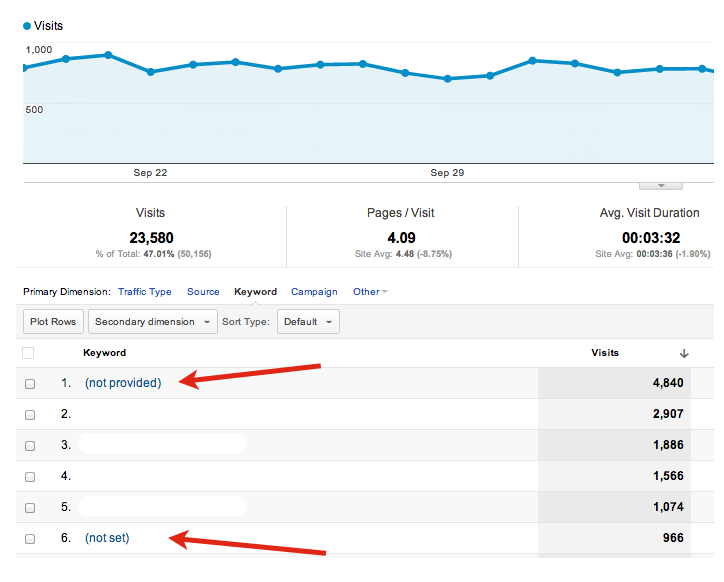In this post I explain the difference between "not set" and "not provided" in Google Analytics.
Not Set:
The ‘keyword’ (not set) simply identifies traffic that doesn’t arrive via a particular keyword and hence may not come via any search at all. This includes traffic coming from email, referral sites, or even things like Google Images. The latter might be confusing, but it helps to know that visitors coming from Google Images and Google Maps are classified under referrals with the source google.com, not organic search. Because keywords are automatically set for search traffic, the (not set) keyword will never appear in your organic Search reports, so it is likely something you won’t have to worry about. Don’t consider this one in light of keyword performance!
In Simple Words - ‘not set’ means that the user didn’t come to your site through a keyword. They came to your site directly or through a referral site.
Not Provided:
Keywords are organic searches from Google but are being hidden from your website since Google is encrypting searches from users (secure searches from users who are logged in to their Google Accounts or otherwise using the secure version of Google.
Simply Say - any keywords searched organically by users who are logged into their Google Accounts (Gmail, Calendar, Apps, etc) will show up in your Analytics reports as (not provided).
Why is Google doing this? Google cites security and privacy reasons for hiding this data.
Firefox Adding to The Problem: The most recent Firefox browser update includes encryption of all Google searches by default, regardless if the user is signed in or not. This occurred in late July 2012 and has caused “Not Provided” numbers to increase.
What this means for you: On average we are seeing approximately 25% (and as high as 50%) of the search term data being hidden in the Not Provided keyword category. This makes year over year keyword analysis difficult as the data will obviously be skewed. This also makes casual keyword research using current data inaccurate.
Just keep in mind:
(Not Set) = Not Search Engine, Referrals and Direct links
(Not Provided) = Protected by Google encryption
I welcome your insight and expertise in the comments, because I am honestly stumped on these issues.
The ‘keyword’ (not set) simply identifies traffic that doesn’t arrive via a particular keyword and hence may not come via any search at all. This includes traffic coming from email, referral sites, or even things like Google Images. The latter might be confusing, but it helps to know that visitors coming from Google Images and Google Maps are classified under referrals with the source google.com, not organic search. Because keywords are automatically set for search traffic, the (not set) keyword will never appear in your organic Search reports, so it is likely something you won’t have to worry about. Don’t consider this one in light of keyword performance!
In Simple Words - ‘not set’ means that the user didn’t come to your site through a keyword. They came to your site directly or through a referral site.
Not Provided:
Keywords are organic searches from Google but are being hidden from your website since Google is encrypting searches from users (secure searches from users who are logged in to their Google Accounts or otherwise using the secure version of Google.
Simply Say - any keywords searched organically by users who are logged into their Google Accounts (Gmail, Calendar, Apps, etc) will show up in your Analytics reports as (not provided).
Why is Google doing this? Google cites security and privacy reasons for hiding this data.
Firefox Adding to The Problem: The most recent Firefox browser update includes encryption of all Google searches by default, regardless if the user is signed in or not. This occurred in late July 2012 and has caused “Not Provided” numbers to increase.
What this means for you: On average we are seeing approximately 25% (and as high as 50%) of the search term data being hidden in the Not Provided keyword category. This makes year over year keyword analysis difficult as the data will obviously be skewed. This also makes casual keyword research using current data inaccurate.
Just keep in mind:
(Not Set) = Not Search Engine, Referrals and Direct links
(Not Provided) = Protected by Google encryption
I welcome your insight and expertise in the comments, because I am honestly stumped on these issues.
Click here to Read More







